An 1890’s Univ football team
Earlier this year, the College Archives acquired an exciting new addition. This is a group photo of the Univ Football XI for the 1894–5 season. Nothing, sadly, is known of its earlier provenance. This photograph is special because, although the Boat Club’s photograph albums go back to the 1860s, our main sequence of sports group photos only starts in 1904, and we have very few such images before that date. Better still, the photograph identifies the sitters.
Here, then, is the photograph (ref. UC:P422/P1/1), with its mount:
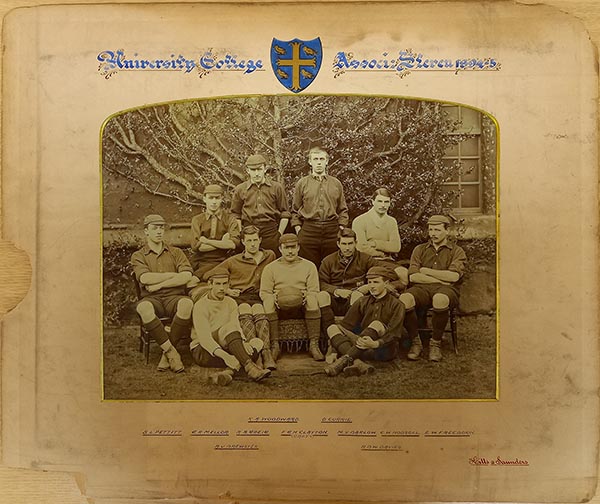
(Click for larger image)
It looks as if the team is sitting somewhere in Radcliffe Quadrangle. You can see that the group in the middle are sitting on a sofa, which must have been hauled out from a nearby room. Many Edwardian group photographs likewise show their sitters grouped around a sofa like this. You can also see that there is not much consistency in the team’s soccer kit: the shirts are not the same, and R. A. Greig, in the middle, sports a rather stylish pair of socks. M. Y. Barlow also stands out because he is wearing a blazer on which the College coat of arms is just visible. The one thing which is consistent is the cap which several members of the team are wearing.
But who are the members of the team? None of them became “great” Old Members, but perhaps that makes them all the more interesting to us, in that, by studying their backgrounds and what we know of their later lives, we can assemble a cross-section of the undergraduates who were up at Univ 130 years ago.
The information on our team has come together from various sources. There are several records within the College, including our Admissions Register, early Tutorial Lists, and a card index of Old Members which was begun in the mid-1920s. Outside our archives, there is Joseph Foster, Oxford Men and their Colleges, 1880–1892, a useful biographical register for most team members, and much has been gathered from census returns. Several members of the team also played cricket, and I have therefore benefitted from extensive on-line research which has been carried out into former cricketers. I am also grateful to Mr. Sandy Rich of Tregeagle Fine Art, the dealer who found the photograph, for supplying some information, not least on the sporting careers of some of our sitters.
Below we meet each in turn…
Kenneth Alexander Woodward
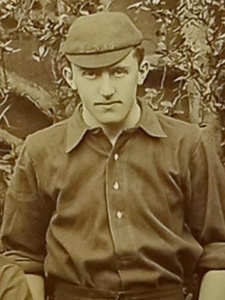
Kenneth Alexander Woodward
Starting in the back row, on the left, stands Kenneth Alexander Woodward (1874–1950; matr. 1893). Woodward was born in Liverpool, the son of a corn merchant, and was educated at Harrow. He came up to Univ to read Classics, getting a Second in Mods in 1895 and a Third in Greats in 1897. Although Woodward appears here as a footballer, he seems to have been a still keener cricketer. His obituary in the 1950 edition of Wisden shows that he had played for the Harrow Cricket XI in 1892 and 1893, and did play one match for Oxford University, but never got a Blue.
He later played occasionally for Herefordshire (where his family had moved to) and Derbyshire. Evidence suggests that Woodward was primarily a batter. Woodward did have a day job: before 1914, at least, he was a teacher at Repton. Wisden also says that he served in the Royal Marine Engineers during the First World War. He later retired to Gloucestershire.
Donald Currie
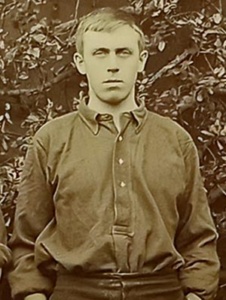
Donald Currie
Next to Woodward stands Donald Currie (1874–1923; matr. 1892). Currie was Scottish, being born in Ayr and educated at Ayr Academy. Joseph Foster calls his father a J.P., but the 1881 census suggests that he had been a draper. Currie read Law, getting a Third in his Finals.
He took an interest in rowing, because he appears in a photo of the 1892 Univ Torpid. Currie’s later life is not easy to trace: the 1911 census suggests that he had returned to Scotland and was working as a solicitor. His Old Member’s card has a letter pasted to it from his brother-in-law reporting that he died in 1923.
Stephen Leonard Pettitt
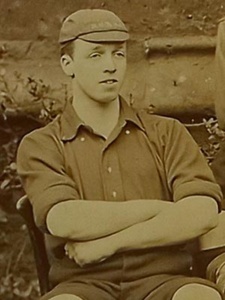
Stephen Leonard Pettitt
Stephen Leonard Pettitt (1875–1950; matr. 1894) sits at the left-hand end of the middle row. He was born in Buxton, Derbyshire, and educated at Repton. At Univ he read Chemistry, getting a Third in his Finals in 1898. His family ran a prep school, Holm Leigh, at Buxton, and Pettitt joined the family business, as it were, becoming its headmaster in 1900 when he was still only in his mid-twenties. He spent the rest of his life in Buxton, and even served as its mayor in 1929.
Sadly, Pettitt had a family embarrassment to live down. According to various accounts of the school (see, for example, robertspublications.com), his father Arthur had founded Holm Leigh, but in 1879 he suddenly disappeared, leaving his wife and family behind. Arthur’s wife Sibilla kept the school going until Pettitt was able to take over. It is a moot point how many of his Univ friends knew this story; it cannot have been easy for Pettitt, either as a schoolboy or a student, regularly to deflect questions about his father, a man whom he hardly knew.
George Rupert Lees Mellor
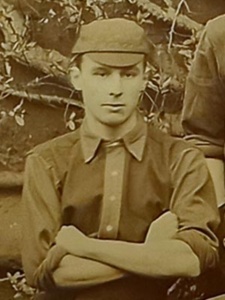
George Rupert Lees Mellor
Just above Pettitt, perched on an arm of the sofa, sits George Rupert Lees Mellor (born 1875; matr. 1893). Mellor came from Lancashire, where his father, a cotton spinner, was employing over 120 workers according to the 1881 census.
Having attended Rossall School, Mellor read History, although perhaps his heart was not in it – he only got a Fourth in his Finals in 1896. Mellor returned to the northwest, settling in Southport, where he became a solicitor. The College lost touch with him some time after 1934, and the date of his death is unknown.
Ronald Alister Greig
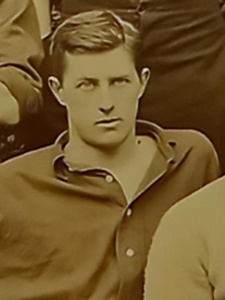 On the left-hand end of the sofa sits Ronald Alister Greig (1873–c. 1951; matr. 1892). Greig was born in Hong Kong, the son of a banker. He was educated at Highgate, and by the time that he came up to Univ his family had moved to Chislehurst, Kent.
On the left-hand end of the sofa sits Ronald Alister Greig (1873–c. 1951; matr. 1892). Greig was born in Hong Kong, the son of a banker. He was educated at Highgate, and by the time that he came up to Univ his family had moved to Chislehurst, Kent.
We do not know what he read: he came up too early to appear on any Tutorial lists, and his Old Members’ card merely says that he “kept 9 terms”, but never took a degree. This lack of success does not seem to have been a problem in later life, for he followed his father in becoming a banker. As with Mellor, the College lost touch with Greig in later years, and someone wrote on his index card “presumed dead 1951”.
Frederick George Clayton
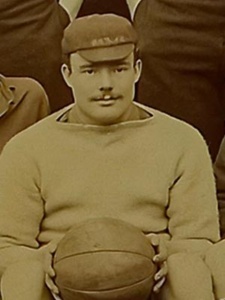
Frederick George Clayton
Right in the middle of the team, holding a football, is its captain, Frederick George Clayton (1873–1946; matr. 1892). Clayton was perhaps the wealthiest member of the team: his father was a banker in Newcastle, who lived in Hexham, at Wylam Hall, employing over a dozen servants. Like Kenneth Woodward above, Clayton went to Harrow, and was another keen cricketer, playing for his school in 1891 and 1892. His obituary in the 1946 edition of Wisden shows that he scored 230 and 70 not out in the Oxford Freshmen’s match of 1893, but did not get a Blue. Clayton was also a skilled rackets player, being a member of the team which beat Cambridge in 1895. He kept up his cricket for longer than his colleagues: he was a member of the Oxford University Authentics team which toured India in 1902/3, and he regularly played for Northumberland Cricket Club. At various times, he was also the club’s Secretary, Treasurer and President.
Meanwhile, he followed his father into the banking business (presumably his employers were lenient to him during the cricket season). There remains, however, a question mark over Clayton’s academic record at Oxford. No Old Members’ card survives for Clayton, which suggests that he had lost touch with Univ by the 1920s. He did not get an Honours degree, and old issues of the Oxford University Calendar suggest that he went down without any degree. Perhaps, however, Clayton moved in a world where his sporting prowess would compensate for any academic shortcomings.
Micah Yates Barlow
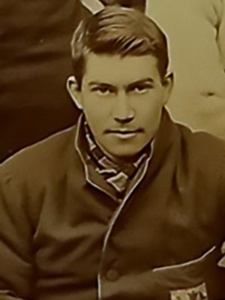
Micah Yates Barlow
On the right-hand end of the sofa sits Micah Yates Barlow (1873–1936; matr. 1892), the third Harrovian in the photo, who, like Woodward and Clayton also enjoyed his cricket, captaining the Harrow XI.
Barlow came from Bury, Lancashire, and his father was a woollen manufacturer. Barlow studied Physiology (the old name for medicine) at Univ, getting a Second in his Finals in 1896. He also played – just the once – for Oxford University, against the Marylebone Cricket Club. He made scores of 3 and 6, and never played for the University again. Barlow’s choice of subject suggests that he might have sought a medical career, but in fact he followed his father and likewise became a woollen manufacturer in his native Lancashire.
Charles Wilfred Pollock Hodsoll
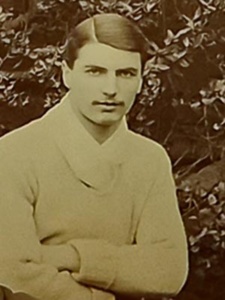
Charles Wilfred Pollock Hodsoll
On the right-hand arm of the sofa is Charles Wilfred Pollock Hodsoll (1874–c. 1966; matr. 1892). Hodsoll came from a more modest background than Micah Barlow, being the son of a farmer in Kent. He attended Maidstone Grammar School, and came up to Univ as a Gunsley Scholar (the Gunsley Scholarships were special awards open only to pupils from the grammar schools at Maidstone or Rochester). Hodsoll read Classics, but his academic career was not distinguished: he got a Third in Mods in 1894, and a Fourth in Greats in 1896.
Not much is known of his later life, but by the 1930s he appears to have become a managing director in a fertilising company.
Ernest Walter Freeborn
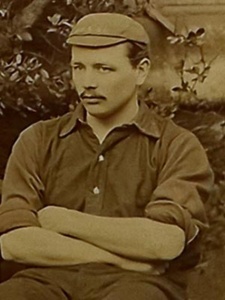
Ernest Walter Freeborn
Sitting on the right-hand edge of the middle row is Ernest Walter Freeborn (1874–1945; matr. 1893). Freeborn perhaps had the most remarkable career of any of the team. He was born in Oxford, in the parish of St. Clement’s, the son of a butcher, and he was educated at Cowley School. He was awarded a Maths Scholarship just before he came up, and he got a First in his Maths Mods in 1894, and a Second in his Finals in 1897. Freeborn then became a schoolmaster, first at Bradfield and then at Harrow. He prospered at Harrow: in 1911 he married the widow of another teacher at the school, and in 1918 he became a housemaster there. He was also the commanding offer of Harrow’s Officer Training Corps during the First World War, and was awarded the rank of Major. In March 1918 he was even formally mentioned by the Secretary of State for valuable service in connection with the war.
Off the record, the schoolboys at Harrow nicknamed him “Juggins”. He did not respond well to changing times: as a housemaster, he was unfortunately notorious for being very unwilling to accept foreigners there. Nevertheless, Freeborn does offer an interesting example of how, even in the 1890s, someone from a very modest background could change his life thanks to winning a scholarship at Oxford.
Arthur James Brewster
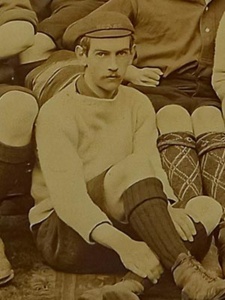
Arthur James Brewster
In the front row of the photo, sitting to the left is Arthur James Brewster (1873–1953; matr. 1892). Brewster was the son of a Suffolk clergyman and was educated at Marlborough. He read Classics, getting a Fourth in his Finals in 1895. On graduating, he followed his father’s path and became an Anglican clergyman himself. He spent several years in Gloucester, where he became a domestic chaplain to the Bishop in 1905, and then an honorary chaplain in 1912. He was also appointed an honorary Canon of Gloucester Cathedral in 1910, and remained the “Rev. Canon Brewster” to the end of his days.
In later years, he held posts in Gloucestershire and Bournemouth, but eventually retired to Gloucestershire at the end of his life.
Robert Bennet Wynne Davies
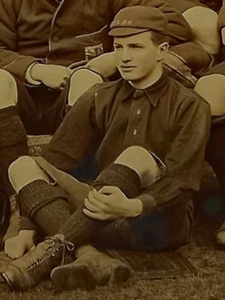
Robert Bennet Wynne Davies
It has so far been possible to find out something about every member of this football team, but our last member, Robert Bennet Wynne Davies (1873–1929; matr. 1891) sitting cross-legged to the right, is also the most elusive. We know that his father was the vicar of Llansilin, on the border between Shropshire and Denbighshire, and that he himself attended Oswestry Grammar School. At Univ he read History, getting a Fourth in his Finals in 1895.
A note on his Old Member’s card says that a friend told the College of his death in 1929. But this is all that I have been able to find out so far, and I cordially invite readers of this piece to see if they can do any better.
One striking thing about this group is their relationship with the First World War. Out of the eleven of them, only Woodward is known to have seen active service, whilst Freeborn was much involved with the Officer Training Corps at Harrow. Perhaps this group were just old enough to escape being called up. On the other hand, they will all undoubtedly have lost friends and family in the war, and those members who became teachers, like Freeborn, Pettitt, or Woodward, will have lost several former pupils.
This group of eleven members of Univ of the 1890s form a surprisingly diverse group. Geographically, they come all over the UK, from Ayr down to Kent. The professions of their fathers range from prosperous bankers, like Clayton’s father, by way of clerics, like Brewster and Davies’ fathers, to Freeborn’s father, an Oxford butcher. Three of them (Barlow, Clayton and Woodward) came from Harrow; but five more (Brewster, Currie, Greig, Mellor and Pettitt) came from more modern public schools, and three (Davies, Freeborn and Hodsoll) came from grammar schools. We see all eleven of them in the same photo, all playing football together side by side. It would be interesting to know just how easily they all socialised together after a game – whether the Harrovians (who, of course, had all known each other since schooldays) found it easier to bond together than to try to talk to the boys from grammar schools. Short of a memoir by one of the team coming to light, we will never know. Sport, however, was a great social leveller in Victorian and Edwardian Britain, and perhaps a shared enjoyment of and skill at playing football might have broken barriers.
Different as the backgrounds of the team were, their later lives, where we know about them, show much greater consistency. Almost all of them went into sturdy middle-class professions, like banking, business, the church, the law or teaching. Indeed, arguably the humblest born of the team, Ernest Freeborn, was the greatest achiever, reaching a senior position in a major public school. It is very easy to assume that 1890s Oxford was still something of a bastion of privilege; yet the eleven members of the Univ Football XI of 1894/5 suggest a picture that is much more nuanced, and perhaps invites us to dig a little more deeply into the world of the 1890s College.
Further Reading
Joseph Foster, Oxford Men and their Colleges, 1880–1892 (Oxford and London, 1893).
Christopher Tyerman, A History of Harrow School 1324–1991 (Oxford, 2000), pp. 445 and 463.
Further selected Univ Treasures are detailed below or explore the whole collection on our News and Features Treasures pages.
Published: 25 August 2023
Explore Univ on social media






 On the left-hand end of the sofa sits Ronald Alister Greig (1873–c. 1951; matr. 1892). Greig was born in Hong Kong, the son of a banker. He was educated at Highgate, and by the time that he came up to Univ his family had moved to Chislehurst, Kent.
On the left-hand end of the sofa sits Ronald Alister Greig (1873–c. 1951; matr. 1892). Greig was born in Hong Kong, the son of a banker. He was educated at Highgate, and by the time that he came up to Univ his family had moved to Chislehurst, Kent.




